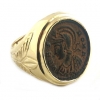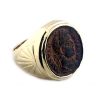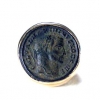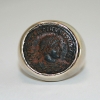|
Ancient Jewelry
|
|
 |
|
 |
|

Price :
$2800.00
Origin: Jerusalem / Israel
Circa: 307 AD to 337 AD
Collection: Roman Bronze Coin Rings
Medium: Bronze-Gold
Facing right the emperor wears a laurel wreath which hangs down More »
Origin: Jerusalem / Israel
Circa: 307 AD to 337 AD
Collection: Roman Bronze Coin Rings
Medium: Bronze-Gold
Facing right the emperor wears a laurel wreath which hangs down the back of the neck and over the right shoulder. His hair is finely delineated, as is his noble profile. On the reverse is inscribed VOT XXX (Votis Tricennalibus) within a laurel-wreath. Constantine' s victory at the Milvian bridge (312) against his rival Maxentius established him as sole ruler of the Roman world. As the result of a dream, he sent his soldiers into battle with crosses on their shields. The ensuing victory convinced Constantine the Christian God was on his side, and henceforth established Christianity as the state religion. The floral pattern on this ring reminds us of the laurel wreaths that symbolized the power of the Roman emperor. - (FJ.6520) « Less
|
|
Ancient Jewelry
|
|
|
|
|
| Vendor Details |
Close |
| Contact Info : |
| Barakat Gallery |
| 405 North Rodeo Drive |
| Beverly Hills |
| California-90210 |
| USA |
| Email : barakat@barakatgallery.com |
| Phone : 310.859.8408 |
|
|
|
|
|
|

Price :
$2800.00
Origin: Israel
Circa: 307 AD to 337 AD
Collection: Coin Jewelry
Style: Roman
Medium: Bronze and Gold
The obverse of this fascinating commemorative coin shows the bust of More »
Origin: Israel
Circa: 307 AD to 337 AD
Collection: Coin Jewelry
Style: Roman
Medium: Bronze and Gold
The obverse of this fascinating commemorative coin shows the bust of Roma facing left wearing a helmet and imperial mantle. On the reverse is the she-wolf of Rome suckling the twins Romulus and Remus. The myth basically narrates the founding of Roman institutions. The two' boys, upon reaching manhood, re-instated the deposed king Numitor of Alba Longa, and established a settlement on the. Palatine. Commemorative coins were issued to mark special occasions, in this case Constantine's visit to Rome, probably around 326 A.D. Though the emperor had already transferred the capitol of the empire to Byzantium, (henceforth known as Constantinople), Rome was the most important city in the West and still retained the spirit of its glorious past. - (FJ.6523) « Less
|
|
Ancient Jewelry
|
|
|
|
|
| Vendor Details |
Close |
| Contact Info : |
| Barakat Gallery |
| 405 North Rodeo Drive |
| Beverly Hills |
| California-90210 |
| USA |
| Email : barakat@barakatgallery.com |
| Phone : 310.859.8408 |
|
|
|
|
|
|

Price :
$2800.00
Origin: Israel
Circa: 307 AD to 337 AD
Collection: Coin Jewelry
Style: Roman
Medium: Bronze and Gold
At the time his father, Constantius l, was appointed Caesar in 293 More »
Origin: Israel
Circa: 307 AD to 337 AD
Collection: Coin Jewelry
Style: Roman
Medium: Bronze and Gold
At the time his father, Constantius l, was appointed Caesar in 293 A.D. Constantine was a tribune at the court of the. Emperor Diocletian. Upon Constantius' death in Britain his son was proclaimed Augustus by the troops (306 A.D.); but it was not until 312 A.D. that Constantine finally defeated his rivals to become sole emperor. Highly gifted in military and political matters, he also took an active interest in religion, elevating Christianity as the state religion, restoring Church property, giving privileges to the clergy and instigating a massive church building program. His transferring the capital of the empire from Rome to Byzantium bas also had a lasting effect. On this fine coin he is shown facing right wearing a diadem. On the reverse is a laurel wreath in which is the legend VOT XX, ie. vota pro solute imperatoris, (for the health or safety of the emperor during his twentieth year of rule). - (FJ.6528) « Less
|
|
Ancient Jewelry
|
|
|
|
|
| Vendor Details |
Close |
| Contact Info : |
| Barakat Gallery |
| 405 North Rodeo Drive |
| Beverly Hills |
| California-90210 |
| USA |
| Email : barakat@barakatgallery.com |
| Phone : 310.859.8408 |
|
|
|
|
|
|

Price :
$2600.00
Origin: Mediterranean
Circa: 4 th Century BC to 3 rd Century BC
Medium: Bronze-Gold
Taras, known as Tarentum to the Romans, was located on a bay opening into what is now More »
Origin: Mediterranean
Circa: 4 th Century BC to 3 rd Century BC
Medium: Bronze-Gold
Taras, known as Tarentum to the Romans, was located on a bay opening into what is now called the Gulf of Taranto. It was the only colony of Sparta, founded by a group responding to instructions from the Delphic Oracle, and, with the only good port on the southeastern coast of Italy, it became a thriving commercial center known for its luxury. Taras was often in conflict with its Italian neighbors and it regularly sought help from foreign mercenaries. When threatened by the Romans c. 281 B.C., Taras called in Pyrrhos of Epeiros, who came to Italy the next year with men and elephants. He fought the Romans in several battles but in 275 B.C. withdrew from Taras and went to assist the Greek cities in Sicily against their enemies the Carthaginians; Taras eventually surrendered to Rome.The rich, patinated bronze of this ancient coin is elegantly contrasted to the luminous gold ring. Together, they perfectly complement each other. The head of a helmeted warrior graces the front of this coin. Although cities rise and fall and great empires soon dissolve, the achievements of antiquity will always be remembered. This coin is a testament to an era, a city, and its people. Today, it is no relic locked behind a glass case; but a glorious ring set in gold. When placed on our fingers, the glories of old are rekindled and the past comes alive again in the present. - (FJ.6740) « Less
|
|
Ancient Jewelry
|
|
|
|
|
| Vendor Details |
Close |
| Contact Info : |
| Barakat Gallery |
| 405 North Rodeo Drive |
| Beverly Hills |
| California-90210 |
| USA |
| Email : barakat@barakatgallery.com |
| Phone : 310.859.8408 |
|
|
|
|
|
|

Price :
$2200.00
Origin: Mediterranean
Circa: 3 rd Century BC
Medium: Bronze-Gold
Lucania is an ancient mountainous region in southern Italy, corresponding to most of the modern region of More »
Origin: Mediterranean
Circa: 3 rd Century BC
Medium: Bronze-Gold
Lucania is an ancient mountainous region in southern Italy, corresponding to most of the modern region of Basilicata, colonized in the seventh century by Greeks who were later subjugated by the warlike Lucani in the fifth century. Recent discoveries of elaborately painted graves at Paestum, a city taken by the Lucanians about 400, suggest that, by the 4th century B.C., the tribe had developed a culture of great vitality and distinction. Although they allied with Rome in 298, the Lucanians opposed and were defeated by that power in the Pyrrhic War (280–275), the Second Punic War (218–201), and the Social War (90–88). Repeated devastations of the area in these conflicts brought about its decline.The obverse of this coin displays a youth with a fillet tied around his head. This mysterious man is identified as the god Apollo by his divine attribute on the reverse: a lyre. Apollo was the most widely revered and influential of all the gods. Apollo, god of divine distance, who sent or threatened from afar; the god who made men aware of their own guilt and purified them of it; who presided over religious law and the constitutions of cities; who communicated to man through prophets and oracles his knowledge of the future and the will of his father, Zeus. His portrait is surely fitting to have on the coin of a Greek colony. Although cities rise and fall and great empires soon dissolve, the achievements of antiquity will always be remembered. This coin is a testament to an era, a city, and its people. Today, it is no relic locked behind a glass case; but a glorious ring set in gold. When placed on our fingers, the glories of old are rekindled and the past comes alive again in the present. - (FJ.6742) « Less
|
|
Ancient Jewelry
|
|
|
|
|
| Vendor Details |
Close |
| Contact Info : |
| Barakat Gallery |
| 405 North Rodeo Drive |
| Beverly Hills |
| California-90210 |
| USA |
| Email : barakat@barakatgallery.com |
| Phone : 310.859.8408 |
|
|
|
|
|
|

Price :
$3600.00
Origin: Mediterranean
Circa: 306 AD to 337 AD
Medium: Bronze-Gold
Constantine I, called Constantine the Great, was the first Roman ruler to be converted to Christianity. More »
Origin: Mediterranean
Circa: 306 AD to 337 AD
Medium: Bronze-Gold
Constantine I, called Constantine the Great, was the first Roman ruler to be converted to Christianity. He was the founder of Constantinople (present-day Istanbul), which remained the capital of the Eastern Roman (Byzantine) Empire until 1453. Constantine the Great unified a tottering empire, reorganized the Roman state, and set the stage for the final victory of Christianity at the end of the 4th century. Many modern scholars accept the sincerity of his religious conviction. His conversion was a gradual process; at first he probably associated Christ with the victorious sun god. By the time of the Council of Nicaea (325), however, he was completely Christian, but still tolerated paganism among his subjects. Although criticized by his enemies as a proponent of a crude and false religion, Constantine the Great strengthened the Roman Empire and ensured its survival in the East. As the first emperor to rule in the name of Christ, he was a major figure in the foundation of medieval Christian Europe
This stunning ring evokes the glory and beauty of the early Christian era and its flowering. The dark green hue of the tarnished bronze is striking when contrasted to the luminosity of the gold mounting. The course of Europe and the world would forever change due to the efforts of Constantine the Great. There is an eternal splendor to this ring, a beauty that radiates from within the coin and envelopes the gold setting. To wear this ring is to evoke the spirit of change. For although time changes and worlds evolve, true beauty and elegance as defined by this ring are eternal and immune to the fancies and whims of individual tastes. - (FJ.6603) « Less
|
|
Ancient Jewelry
|
|
|
|
|
| Vendor Details |
Close |
| Contact Info : |
| Barakat Gallery |
| 405 North Rodeo Drive |
| Beverly Hills |
| California-90210 |
| USA |
| Email : barakat@barakatgallery.com |
| Phone : 310.859.8408 |
|
|
|
|
|
|

Price :
$2700.00
Origin: Mediterranean
Circa: 379 BC to 395 BC
Collection: Coin Jewelry
Style: Roman
Medium: Bronze and Gold
Theodosius I, full name Flavius Theodosius, called Theodosius More »
Origin: Mediterranean
Circa: 379 BC to 395 BC
Collection: Coin Jewelry
Style: Roman
Medium: Bronze and Gold
Theodosius I, full name Flavius Theodosius, called Theodosius the Great, was Roman emperor of the East (379-395) and of the West (394-395), and the last man to rule a united Roman Empire. Theodosius was born in Spain, the son of the Roman general Theodosius. When the eastern Roman emperor Valens was killed fighting the Visigoths at Adrianople in 378, the western Roman emperor Gratian chose Theodosius to rule in the East; he was crowned the following year. In 382, after numerous skirmishes, Theodosius negotiated a favorable peace with the Goths, permitting them to reside in his empire on the condition that they serve in his army. After the murder of Gratian in 383, Theodosius recognized the usurper Magnus Clemens Maximus as emperor of the West, with the exception of Italy, where Valentinian II continued to rule as Gratian's legal successor. When Maximus invaded Italy in 388, Theodosius defeated and killed him, restoring Valentinian as Roman emperor of the West. Theodosius was a strong champion of Orthodox Christianity; he persecuted the Arians and discouraged the practice of the old Roman pagan religion. In 392, Valentinian was murdered by his general Arbogast, who set up Eugenius as puppet ruler in his place. Theodosius again marched to Italy, where he defeated Arbogast and Eugenius in September 394. During the following four months he was the ruler of both East and West. After his death at Milan on January 17, 395, his sons Arcadius in the East and Flavius Honorius in the West succeeded him.This stunning ring evokes the glory and beauty of the early Christian era and its flowering. The dark green hue of the tarnished bronze is striking when contrasted to the luminosity of the gold mounting. The course of Europe and the world would forever change due to the efforts of Theodosius the Great. There is an eternal splendor to this ring, a beauty that radiates from within the coin and envelopes the gold setting. To wear this ring is to evoke the spirit of change. For although time changes and the world evolves, true beauty and elegance as defined by this ring are eternal and immune to the fancies and whims of individual tastes. - (FJ.6609) « Less
|
|
Ancient Jewelry
|
|
|
|
|
| Vendor Details |
Close |
| Contact Info : |
| Barakat Gallery |
| 405 North Rodeo Drive |
| Beverly Hills |
| California-90210 |
| USA |
| Email : barakat@barakatgallery.com |
| Phone : 310.859.8408 |
|
|
|
|
|
|

Price :
$3700.00
Origin: Mediterranean
Circa: 358 BC to 336 BC
Medium: Bronze-Gold
Phillip II of Macedon has been proclaimed to be the greatest king in European History. He changed Macedon More »
Origin: Mediterranean
Circa: 358 BC to 336 BC
Medium: Bronze-Gold
Phillip II of Macedon has been proclaimed to be the greatest king in European History. He changed Macedon from a divided group of fiefdoms into a powerful unified kingdom that vanquished great empires and became a terror in the ancient world. Phillip was a diplomatic genius possessing a natural strategic ability. Under his leadership, the Macedonian army would become the most formidable fighting force in the ancient world. After trade with Greece declined, Phillip used the resources of Macedon to acquire revenue to build up his army. Phillip also sought to improve the military by constantly training and drilling his soldiers in the use of new weapons and lighter armor. New, innovative tactics were also developed and utilized. Phillip's most formidable opponent was Athens. Although he sought to be on good diplomatic terms with Athens initially, they would eventually engage in war. Athens attacked Phillip, but was defeated at the battle of Charisoneia on August 22, 338 B.C. Afterwards, Phillip concentrated on expanding his empire to the east. However, before his dream was realized, he was assassinated in 336 B.C. His son, Alexander the Great, would ascend the throne go on to realize his father’s vision of an expansive eastern empire.The glories of antiquity shine again with renewed brilliance and luster. Phillip and Alexander are among the most celebrated and enduring figures of history. The legend surrounding these individuals becomes reality when this ring is worn. The past literally comes alive. This ancient coin in not a relic of the past displayed behind glass in a museum; but mounted in this ring, the coin is a stunning centerpiece appreciated for its age as much as its beauty and superior craftsmanship. - (FJ.6624) « Less
|
|
Ancient Jewelry
|
|
|
|
|
| Vendor Details |
Close |
| Contact Info : |
| Barakat Gallery |
| 405 North Rodeo Drive |
| Beverly Hills |
| California-90210 |
| USA |
| Email : barakat@barakatgallery.com |
| Phone : 310.859.8408 |
|
|
|
|
|
|

Price :
$4300.00
Origin: Mediterranean
Circa: 235 AD to 238 AD
Medium: Bronze-Gold
It was rumored that Maximinus could drink sixty pints of wine and eat forty pounds of meat a day. The More »
Origin: Mediterranean
Circa: 235 AD to 238 AD
Medium: Bronze-Gold
It was rumored that Maximinus could drink sixty pints of wine and eat forty pounds of meat a day. The popular barbarian soldier was also reputed to be over eight feet tall and to have worn his wife's bracelet as a ring. The stories of his physical feats were even more astounding. He was an excellent warrior but a terrible statesman. He led his armies against the Germans but fought as a foot soldier, slaying enemy soldiers easily due to his immense size and strength. He ran the government in much the same way, often exiling or murdering senators who dared to oppose him. Maximinus' harsh policies angered the people of the empire and in the provinces. In A.D. 238, the citizens of North Africa rebelled against Maximinus' procurator, the financial officer in charge of taxes. They proclaimed an eighty-seven year old man by the name of Gordianus emperor and his son was made co- emperor with him. When news of the rebellion reached Maximinus, he decided to march on Rome. Already unpopular with the people, this move caused him to be disdained. While laying siege to the city of Aquileia, whose citizens stoutly resisted, Maximinus’ German troops became demoralized and decided to do away with him.The natural splendor of the precious metals is allowed to shine in this ring. The rich hues of the patinated bronze and the gold complement each other. In this ring, the present and the past combine. The classic reserved form of the modern ring enhances the timeless beauty and majesty of the ancient coin. To wear this ring is to reconnect with the past while simultaneously exhibiting style and elegance that is contemporary and yet timeless. - (FJ.6633) « Less
|
|
Ancient Jewelry
|
|
|
|
|
| Vendor Details |
Close |
| Contact Info : |
| Barakat Gallery |
| 405 North Rodeo Drive |
| Beverly Hills |
| California-90210 |
| USA |
| Email : barakat@barakatgallery.com |
| Phone : 310.859.8408 |
|
|
|
|
|
|

Price :
$2400.00
Origin: Mediterranean
Circa: 337 AD to 340 AD
Collection: Coin Jewelry
Style: Roman
Medium: Bronze and Gold
Constantine II was born in 316 A.D., the eldest son of More »
Origin: Mediterranean
Circa: 337 AD to 340 AD
Collection: Coin Jewelry
Style: Roman
Medium: Bronze and Gold
Constantine II was born in 316 A.D., the eldest son of Constantine the Great and his second wife, Fausta. When the empire was divided upon the death of his father in A. D. 337 between him and his brothers Constantius II and Constans I, he inherited Gaul and most of Western Europe. Together with his brothers, Constantine II systematically murdered any of his relatives that he considered a threat to his throne. They left their young cousin Julian alive, however, and Julian ultimately did lead a successful revolt and become emperor. Part of the arrangements made between the three brothers included Constantine II acting as regent for Constans, who was considered somewhat young to rule in his own right. In 340, Constantine II and Constans got into an argument over the administration of Italy. Constantine II gathered an army to go chastise his brother, but was soundly defeated in the battle that took place near the city of Aquileia, in the North of Italy close to the western slopes of the Julian Alps. Constantine II was killed in the battle after bitter fighting.This stunning ring evokes the glory and beauty of the early Christian era and its flowering. The rich umber hue of the tarnished bronze is striking when contrasted to the luminosity of the gold mounting. The course of Europe and the world would forever change due to the efforts of Constantine the Great and his sons. There is an eternal splendor to this ring, a beauty that radiates from within the coin and envelopes the gold setting. To wear this ring is to evoke the spirit of change. For although time changes and worlds evolve, true beauty and elegance as defined by this ring are eternal and immune to the fancies and whims of individual tastes. - (FJ.6634) « Less
|
|
Ancient Jewelry
|
|
|
|
|
| Vendor Details |
Close |
| Contact Info : |
| Barakat Gallery |
| 405 North Rodeo Drive |
| Beverly Hills |
| California-90210 |
| USA |
| Email : barakat@barakatgallery.com |
| Phone : 310.859.8408 |
|
|
|
|
|
|
|
|

|


